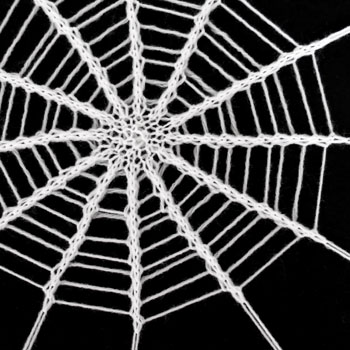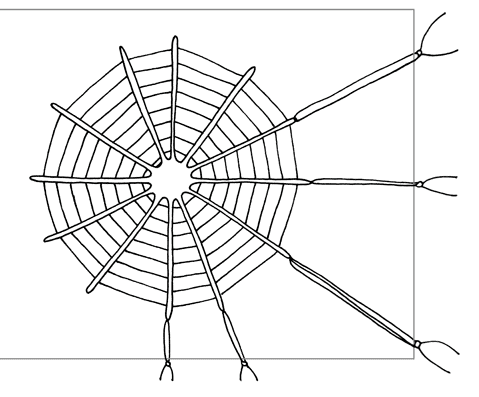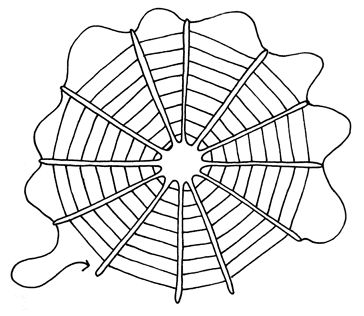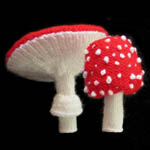Cobweb (R3)

String up some lacy spider webs this Halloween. The pattern has an easy repeat so you can make them as big as you like, or make them scruffy by changing directions/ adding extra yarn-arounds.
A printable version of this pattern is available.
You will need:
- white yarn (4 ply)
- frame for stretching (optional)
- 4 x double ended knitting needles (3.25mm)
- tapestry needle
- scissors
Pattern:
This pattern will use the abbreviation SP which means 'spoke' and is worked as follows:
- k2 sts
- Slip the same 2 sts back to the first needle without twisting.
- Take the yarn across the back of the stitches and k2 again (as for i-cord).
(A list of other abbreviations is available.)
Cast on 6 sts and join into the round.
- Round 1: k –
- Round 2: kfb x 6 (12)
- Round 3: k –
- Round 4: kfb x 12 (24)
- Round 5: k –
- Round 6: [yfwd, SP] x 12 (36)
- Round 7: [yfwd, drop 1, SP] x 12 (36)
- Round 8: [yfwd, drop 1, SP] x 12 (36)
- Round 9: [yfwd, yrn, drop 1, SP] x 12 (48)
- Round 10: [yfwd, yrn, drop 1, SP] x 12 (48)
- Round 11: [yfwd, yrn, drop 1, SP] x 12 (48)
- Round 12: [yfwd, yrn x 2, drop 2, SP] x 12 (60)
- Round 13: [yfwd, yrn x 2, drop 3, SP] x 12 (60)
- Round 14: [yfwd, yrn x 2, drop 3, SP] x 12 (60)
Making Up:
I think the web looks best stretched out on a frame so that all the threads are pulled taught. That might not be practical for all uses so I've written out two possible casting off methods here – framed and loose. You might also consider sewing the live stitches to a backing fabric or finishing off as for the lace snowflake decoration it all depends on what you want to use your cobweb for.
Framed

Cut twelve lengths of yarn.
Starting at the beginning of the round drop the three yarn-over stitches then thread one length of yarn through the two live stitches. Repeat until each spoke is threaded onto a length of yarn.
Tie one length of yarn to your chosen frame. Find the yarn attached to the opposite spoke, stretch the cobweb out and tie the thread off. Repeat for all remaining spokes.
Sew the loose ends into the spokes.
A frame can be anything that allows you to tie the spokes into position – metal shelves, a clothes horse, a bunch of sticks tied together, etc. How about an i-cord covered right-angled triangle made from wire. Hide the loose ends of the ties by sewing them into the i-cord them fix the triangle in the corner of a door or window. Properly spidery.
Loose

Cut a long tail of yarn.
Starting at the beginning of the round drop the three yarn-over stitches then thread the tail end through the next two stitches. Keep everything as loose as possible. Repeat for all remaining stitches.
Tug the tail of yarn tighter until it looks like just another thread of the web. Make sure the spokes are spread evenly along it's length.
Sew the two loose ends into the spokes.
Notes:
Needle/Yarn Size
As with most ODDknit patterns the yarn and needle sizes in the "you will need" section are just a guide. Feel free to improvise with whatever needles and yarn you have lying around - that's half the fun!
<<< See more Creepy Crawlies
<<< See more Halloween Knits
© 2013 All desgins and images are copyright of ODDknit.









